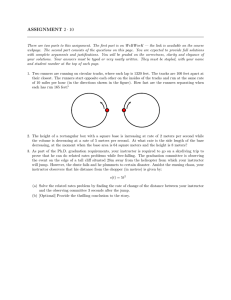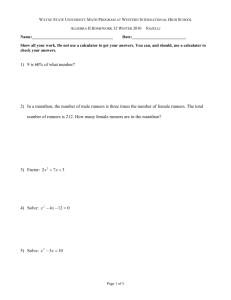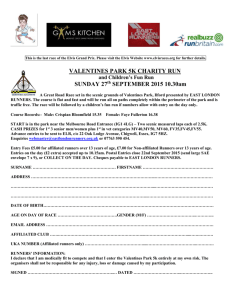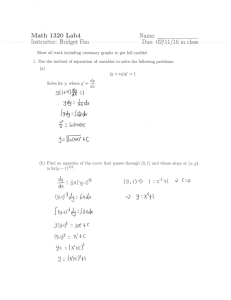ASSIGNMENT 2 · 10
advertisement
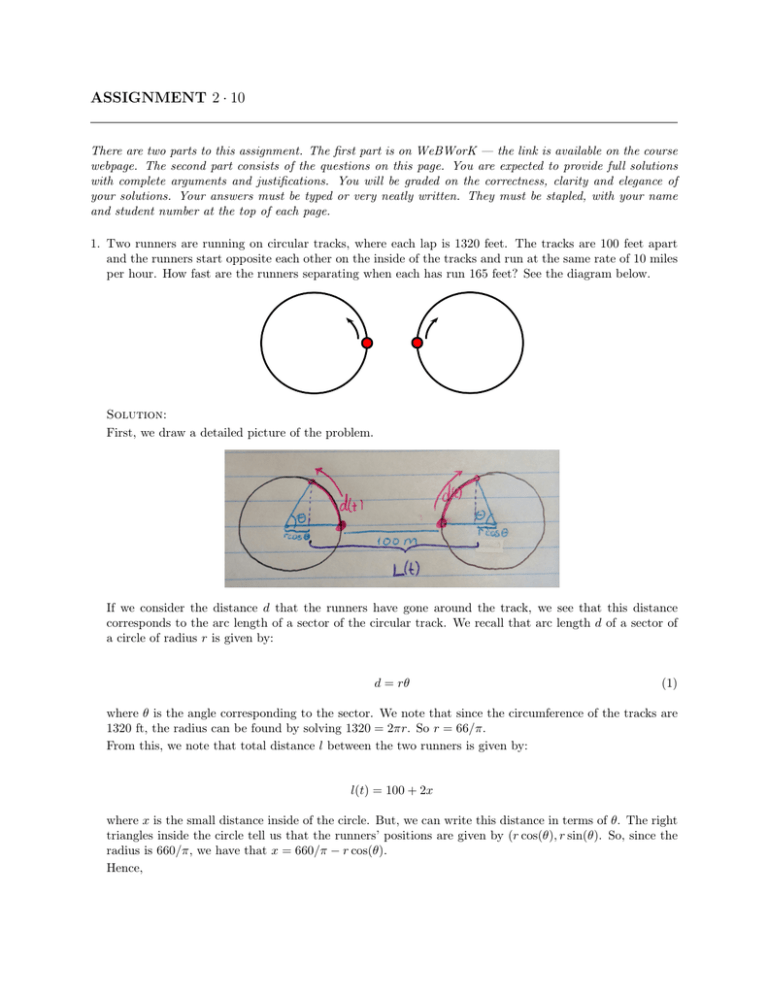
ASSIGNMENT 2 · 10 There are two parts to this assignment. The first part is on WeBWorK — the link is available on the course webpage. The second part consists of the questions on this page. You are expected to provide full solutions with complete arguments and justifications. You will be graded on the correctness, clarity and elegance of your solutions. Your answers must be typed or very neatly written. They must be stapled, with your name and student number at the top of each page. 1. Two runners are running on circular tracks, where each lap is 1320 feet. The tracks are 100 feet apart and the runners start opposite each other on the inside of the tracks and run at the same rate of 10 miles per hour. How fast are the runners separating when each has run 165 feet? See the diagram below. Solution: First, we draw a detailed picture of the problem. If we consider the distance d that the runners have gone around the track, we see that this distance corresponds to the arc length of a sector of the circular track. We recall that arc length d of a sector of a circle of radius r is given by: d = rθ (1) where θ is the angle corresponding to the sector. We note that since the circumference of the tracks are 1320 ft, the radius can be found by solving 1320 = 2πr. So r = 66/π. From this, we note that total distance l between the two runners is given by: l(t) = 100 + 2x where x is the small distance inside of the circle. But, we can write this distance in terms of θ. The right triangles inside the circle tell us that the runners’ positions are given by (r cos(θ), r sin(θ). So, since the radius is 660/π, we have that x = 660/π − r cos(θ). Hence, l(t) = 100 + 2( 660 660 − cos(θ(t)) π π (2) Now, we use implicit differentiation to find that l0 (t) = 1320 sin(θ(t))θ0 (t) π So, in order to find l0 (t) when d = 165, all we need are θ and θ0 when d = 165. We can use the arc lenth equation in (1) to find that 660 θ π π θ= 4 165 = Also, we can take the derivative of (1) to see: 660 f t)θ0 (t) π 660 10 mi/hr = ( f t)θ0 (t), since d0 (t) = 10 mi/hr π 5280f t π θ0 (t) = 10mi/hr( )( ) 1mile 660 θ0 (t) = 80πrad/hr d0 (t) = ( Hence, when d = 165f t the runners are separating at 1320 sin(θ(t))θ0 (t) π 1320 π = sin( )(80π) π 4 105600 = √ ft/hr 2 20 = √ mi/hr 2 2 · 10 = √ mi/hr 2 √ = 10 2mi/hr l0 (t) = 2. The height of a rectangular box is increasing at rate of 2 meters per second while the volume is decreasing at a rate of 5 meters per second. If the base of the box is a square, at what rate is one of the sides of the base decreasing, at the moment when the base area is 64 square meters and the height is 8 meters? Solution: Let H = H(t) be the height of the box, let x = x(t) be the length of a side of the base, and let V = V (t) = H(t)(x(t))2 be the volume. It is given that H 0 (t) = 2m/s and V 0 (t) = 2x(t)x0 (t) + x2 H 0 (t) = −5m3 /s. The question is to find the value of x0 (t) when x2 = 64m2 and H = 8m. Thus, 2x(t)x0 (t) + x2 H 0 (t) = −5m3 /s 2(8m)x0 (t) + 64m2 (2m/s) = −5m3 /s 133 x0 (t) = m/s 128 Thus, when x2 = 64m2 and H = 8m, one of the sides of the base is decreasing at the rate of 133 128 m/s. 3. As part of the Ph.D. graduation requirements, your instructor is required to go on a skydiving trip to prove that he can do related rates problems while free-falling. The graduation committee is observing the event on the edge of a tall cliff situated 28m away from the helicopter from which your instructor will jump. However, the chute fails and he plummets to certain disaster. Amidst the ensuing chaos, your instructor observers that his distance from the chopper (in metres) is given by: s(t) = 5t2 (a) Solve the related rates problem by finding the rate of change of the distance between your instructor and the observing committee 3 seconds after the jump. (b) [Optional] Provide the thrilling conclusion to the story. Solution: (a) Consider the following triangle where C is the committee, H is the helicopter and I is the instructor. C 28 x H s I Let x be the distance from I to C. Using the Pythagorean Theorem we establish a relationship between x and s 282 + s2 = x2 . We differentiate both sides with respect to time using chain rule 2s ds dx = 2x dt dt and rearrange to find an expression for dx/dt, the desired quantity dx s ds = . dt x dt We require dx/dt when t = 3 so it remains to find the quantities x, s and ds/dt at this time. Note s(3) = 5(3)2 = 45. So, when t = 3 p x = 282 + 452 = 53. Finally ds = s0 (t) = 10t dt so s0 (3) = 30. Putting everything together gives, at t = 3 45 1350 dx = · 30 = m/s. dt 53 53 (b) Deus ex machina.
